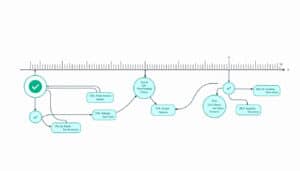In a context where innovation has become an imperative for businesses, crossing benchmarking and design thinking emerges as a particularly relevant strategy. By integrating best practices identified through benchmarking into a creative process like design thinking, organizations can not only draw inspiration from industry leaders but also identify untapped opportunities. This hybrid approach paves the way for innovative solutions, fostering an environment where creativity and efficiency intertwine to meet contemporary challenges. It is a true lever to stimulate the impact and relevance of innovative projects.
🔥 Nous recommandons Ideamap
Ideamap est l’outil idéal pour un brainstorming ou un projet collaboratif. Grâce son interface facile et à ses fonctions IA, Ideamap booste votre créativité tout en favorisant une meilleure organisation de vos idées pour atteindre vos objectifs.

In a constantly evolving world, companies must adopt effective strategies to remain competitive. One of the methodologies that has gained popularity is benchmarking, an evaluation process that allows organizations to measure their performance against that of their competitors or other sectors. At the same time, design thinking emerges as a user-centered approach, dedicated to generating creative solutions by approaching problems from a different angle. The intersection of these two disciplines opens the way to innovation that not only meets customer needs but also anticipates them.
Benchmarking is fundamental for identifying best practices within a sector or among different sectors. By analyzing the high-performing practices of market leaders, a company can gain valuable insights that will guide it in developing solutions adapted to its own challenges. However, it is essential that this process does not merely limit itself to the simple imitation of competitors. The true strength of benchmarking lies in its ability to provide a rigorous analytical framework that, combined with the adoption of design thinking, fosters the emergence of innovative ideas.
Design thinking, for its part, relies on a deep understanding of users. By involving customers in the creation process, this method allows for identifying unmet needs and exploring solution paths that would otherwise be overlooked. By integrating insights gained through benchmarking, design thinking becomes a powerful tool for innovation. Indeed, it allows for contextualizing the data collected on competitors, enriching it with a user-centered perspective.
The intersection of these two approaches can take the form of collaborative workshops, where teams come together to exchange ideas and perspectives. These innovation workshops are essential for stimulating creativity within teams. By setting up brainstorming sessions, professionals can draw inspiration from best practices identified during benchmarking analyses while taking into account the specific needs of users. These workshops encourage open dialogue and allow participants to develop innovative solutions that meet both business expectations and user-centric demands.
The success of this synergy also relies on company culture. For benchmarking and design thinking to be effective, it is crucial to create an environment where experimentation and failure are accepted. This involves implementing virtual workshops that encourage continuous innovation. These online sessions allow teams to engage remotely while providing a platform to explore new ideas, strengthen collaboration, and facilitate knowledge sharing.
By becoming a business routine, the combination of benchmarking and design thinking fosters the emergence of a true innovation dynamic. In the digital age, where user expectations are rapidly evolving, it is vital for companies to adopt agile and adaptive methods. Frugal innovation, a concept aimed at creating value with fewer resources, can also be integrated into this approach. Thus, companies are better equipped to navigate complex environments and develop sustainable solutions that resonate with their customer base.
To explore these concepts in more depth, it is possible to discover enriching articles on the subjects of open innovation and benchmarking as a catalyst for innovation in the technology sector, as well as future trends in collaborative tools. These resources can prove invaluable for any company eager to embark on this dynamic journey of innovation.

FAQ: Crossing benchmarking and design thinking for innovation
What is benchmarking? Benchmarking is a comparison method that assesses the performance of a company’s processes, products, or services against the best practices in the market.
Why is design thinking important for innovation? Design thinking is a user-centered approach that fosters creativity and empathy, providing an ideal framework for developing innovative solutions.
How can benchmarking stimulate innovation? By identifying the strengths and weaknesses of competitors, benchmarking allows companies to uncover opportunities for improvement and innovation.
What is the link between benchmarking and design thinking? These two approaches complement each other by using comparative data from benchmarking to inform the empathy and definition phases of design thinking, leading to more relevant solutions.
What is frugal innovation? Frugal innovation refers to the development of effective and economically viable solutions that provide low-cost innovations, often from limited resources.
What are the challenges of disruptive innovation? The main challenges include adapting existing business models, acceptance of new technologies by users, and managing change within traditional organizations.
How to foster an innovation culture within a company? By organizing virtual workshops and brainstorming sessions, teams can collaborate and share ideas, creating an environment conducive to innovation.
What brainstorming techniques can be used for product innovation? Techniques such as mind mapping, empathy maps, or role-playing can help unleash creativity and generate new ideas.
How does digital brainstorming transform innovation? Digital brainstorming allows teams to collaborate more flexibly and effectively, facilitating the sharing of ideas without geographical constraints.
What collaborative tools can support innovation? Tools such as project management platforms, online collaboration boards, and idea-sharing applications are essential for supporting an innovation culture within teams.














